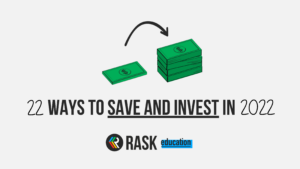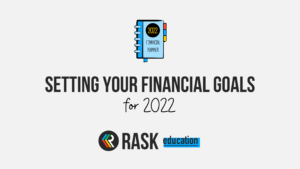I’ve taken just about everything we know about the share market and distilled it to these five “essential” terms or concepts every investor needs to understand.
Be sure to use the extra resources further down the page to learn more.
Diversification explained
Diversification is a portfolio management technique used to lower the risk of an investment portfolio.
If you have $100,000 and you buy 20 shares equally, you will have $5,000 in each. If one share goes to zero (i.e. the company goes bankrupt), the other 19 shares ($95,000) ideally shouldn’t be affected.
Typically, having 20 investments is better or “more diversified” than having just one share in your portfolio. As they say, ‘don’t put all your eggs in one basket’.
Think about it this way:
“In a diversified portfolio, the overall portfolio cannot perform better than the best-performing investment. However, it cannot perform worse than the worst-performing investment.”
There is a limit to diversification. For example, if you have 199 shares and add one more (the 200th), the benefits of extra diversification are so small it probably isn’t worth the effort.
It’s also important to know that diversification doesn’t protect you against everything. For example, even if you have 20 – 40 different shares, you would still be exposed to the “market risk” – the day to day risks in all shares.
For example, imagine you buy 10 investment properties. If you are diversified you would make sure the 10 properties are from different suburbs or neighborhoods. However, even if you are ‘well diversified’, if the entire housing market falls (i.e. “market risk”) your portfolio would still be affected. You might be well diversified but you are still exposed to housing.
When it comes to shares, diversifying across sectors (e.g. technology, retail, mining, etc.) and geographies are further considerations.
Rask tip: ETFs are a collection of shares, bonds or other investments in one ‘basket’. You can invest in the entire basket/ETF starting with just $500. They might help you diversify your portfolio.
What is the ASX 200?
If you’ve ever watched the morning or evening news you would have seen the financial market snippet and these six digits: ASX 200.
The S&P/ASX 200 is an Australian stock market index, created and maintained by Standard & Poor’s (S&P).
The ASX 200 tracks the share prices of the 200 largest public companies in Australia, ranked by their market capitalisation.
The ASX 200 will increase if enough companies in the top 200 see their share prices rise, and fall when the shares of these companies are sold down.
The next time the ASX 200 comes on the telly, if it says “the ASX 200 ended down 2%” that’s financial jargon for ‘the Australian share market fell 2%.’
Dividends & franking credits
Dividends are a return of a company’s profits to shareholders. Every 6 or 12 months, the company’s board of directors will meet to decide how much (if any) dividends to pay to shareholders.
Dividends:
- Optional. They’re not guaranteed.
- Are typically paid every 6 months via cheque or direct deposit (if you set it up)
- Will be announced to the ASX, typically with the company’s results
- Can come with franking credits (for Australian companies and eligible shareholders)
Franking credits are a type of ‘tax credit‘ which are paid with dividends and are stored at the Australian Tax Office on your behalf. Only Australian tax-paying companies can offer franking credits to shareholders.
Franking credits can boost your income because the ‘credits’ are stored against your name and then applied to your tax return each year (e.g. you benefit from them when you complete your tax return).
You must be an eligible Australian shareholder and hold shares in a company for at least 45 days to receive franking credits with your dividends.
For example, a “fully franked dividend” might be announced by Australian company like Telstra or Commonwealth Bank. If you are a shareholder in these companies and they decide to pay a dividend, you might also get some franking credits applied to your name at the ATO.
Rask tip: The best type of dividends are “fully franked” dividends because they carry the most credits for eligible shareholders.
When is tax paid on shares?
If you own shares, you will pay tax on your investments each year when you complete your tax return for the year to June 30.
In Australia, an individual (e.g. if you invest via your own name) will pay two types of investing-related tax, as follows:
- Capital gains tax (CGT). If you buy a share/ETF for $10 and sell it for $25, that’s a $15 capital gain which needs to be added to your tax return.
Rask tip: Speak to your accountant about ways to minimise capital gains tax (e.g. if you hold your shares for over 12 months).
- Income tax. This is tax paid on dividends you receive from shares. This may also include short term capital gains (e.g. trading profis or if you make a gain on a share after holding it for less than one year).
Note: ETF investors will receive an annual statement from their ETF provider (e.g. between July and September) which provides a list of which types of tax they will need to report to the ATO. This can include foreign income and can be different to the cash that you actually received in distributions that year.
Are share prices and valuations the same thing?
It’s easy to confuse the terms ‘value’ and ‘price’ – most professional investors do it from time to time. However, there is a difference between a share price and a share valuation.
As Warren Buffett said, ““Price is what you pay, value is what you get.”
Another great quote is:
“Price is what you are asked to pay, value is what you are willing to pay.”
Analysts and professional investors will use different techniques to determine the ‘value’ of the investment.
For example, a stock analyst researching BHP Group (ASX: BHP) might use a combination of techniques such as:
- Ratio analysis (e.g. the price-earnings ratio)
- Discounted cash flow (DCF), which uses the cash flow or profits from a company
- Internal rate of return (IRR)
The important point to remember is this:
Analysts and investors can have different estimates of value.
For example, Analyst One might say “BHP shares are valued at $40”, but Analyst Two might say “BHP shares are worth $30”.
Why are they different?
Valuations require the individual (i.e. the analyst) to make a prediction about the future of the business and/or industry within which it operates.
Analyst One and Analyst Two could use different estimates of the future to create their valuation models.
Rask Tip: A share’s valuation is also called its “intrinsic value”, and brokers call their estimates “price targets” or “fair value”.
Valuations are not a guarantee. Be cautious of anyone who tells you the value of a share is definite or exact.



